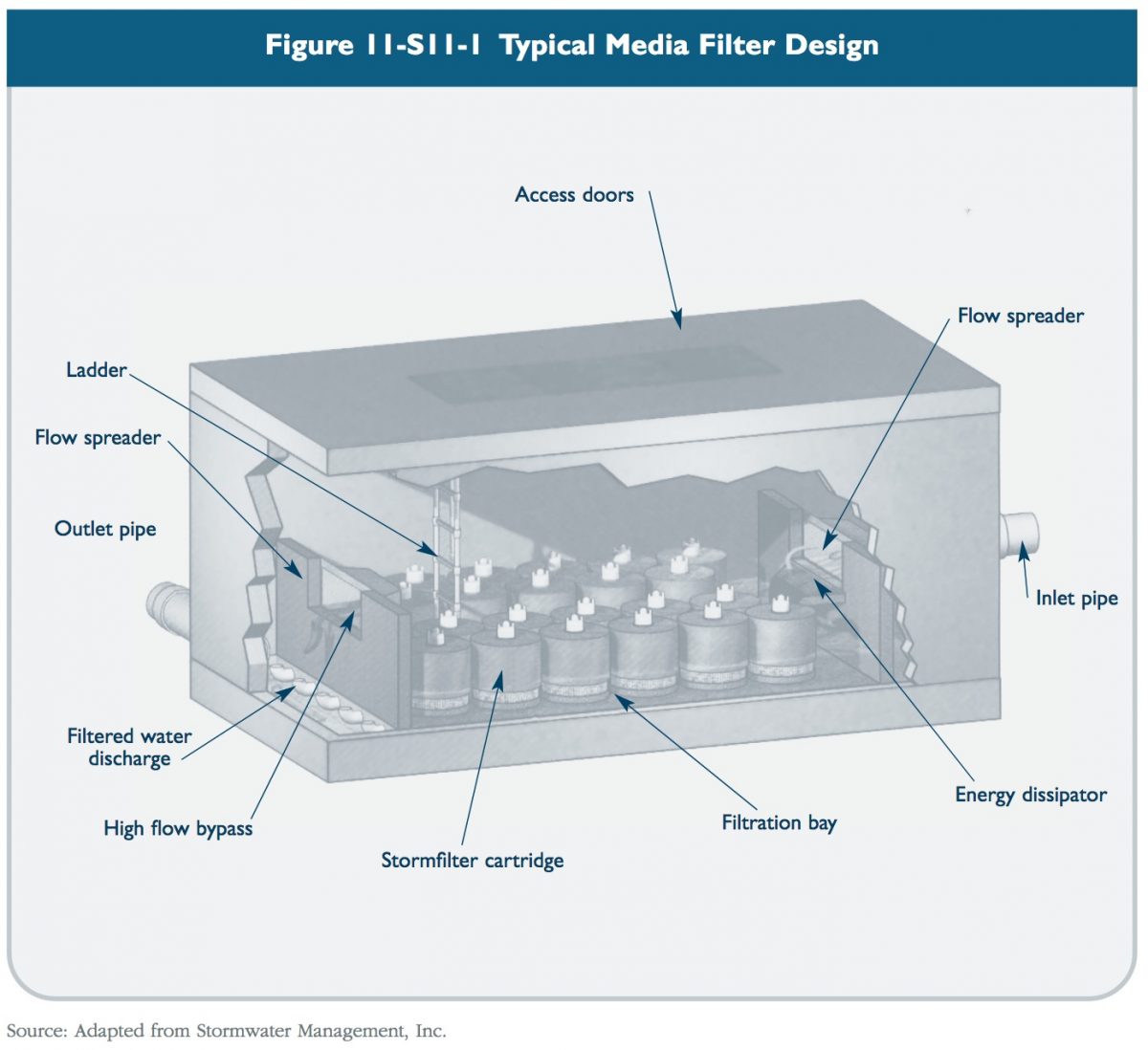Description
Media filters are an evolution of fixed bed sand filtration technology. In this type of treatment practice, media is placed within filter cartridges that are typically enclosed in underground concrete vaults. Stormwater is passed through the media, which traps particulates and/or soluble pollutants. Various materials may be used as filter media including pleated fabric, activated charcoal, perlite, amended sand and perlite mixes, and zeolite. Selection of filter media is largely a function of the pollutants targeted for removal. Pretreatment prior to the filter media is typically necessary for stormwater with high total suspended solids, hydrocarbon, and debris loadings that may cause clogging and premature filter failure (Washington, 2000). Maintenance requirements for filter media include sediment removal and replacement of media cartridges. Figure 11-S11-1 shows an example of a common media filter design (no endorsement of any particular product is intended).

Reasons for Limited Use
* Limited peer-reviewed performance data available. (See Chapter Six for a description of the recommended evaluation criteria and protocols for consideration of these technologies as primary treatment practices.)
* Require frequent maintenance and replacement. Can become a source of pollutants unless maintained frequently.
* Susceptible to clogging. Pretreatment is required for high solids and/or hydrocarbon loadings and debris that could cause premature failure due to clogging.
Suitable Applications
* Specialized applications such as industrial sites for specific target pollutants (i.e., organics, heavy metals, and soluble nutrients) that are not easily removed by other conventional treatment practices.
* For retrofit of existing stormwater drainage systems, particularly in highly developed (ultra-urban) areas where larger conventional treatment practices are not feasible or where aboveground treatment practices are not an option.
* For pretreatment or as part of a stormwater treatment train in conjunction with other stormwater management practices.
Design Considerations
Due to the proprietary nature of these products, media filters should be designed according to the manufacturer’s recommendations. Some general design considerations for media filters include:
* Sizing/Design: Media filters should primarily be used in an off-line configuration to treat either the design water quality volume or the design water quality flow (peak flow associated with the design water quality volume). Upstream diversion structures or bypass systems built into the unit are used to bypass higher flows around the device. The size and number of filter cartridges are determined based upon the anticipated solids loading rate and design water quality flow. Filter media are selected based on pollutants of concern. Potential mosquito entry points should be sealed (adult female mosquitoes can use openings as small as 1/16 inch to access water for egg laying).
* Maintenance: Frequent inspection and cleanout is critical for proper operation of media filters. Structures that are not maintained can be significant sources of pollution. Manufacturer’s operation and maintenance guidelines should be followed to maintain design flows and pollutant removals. Typical maintenance includes removal of accumulated oil and grease, floatables, and sediment from the filter chamber and replacement of the filter cartridges.
Plans for media filters should identify detailed inspection and maintenance requirements, inspection and maintenance schedules, and those parties responsible for maintenance.
* Sediment Disposal: Polluted water or sediment removed from these devices should be properly handled and disposed in accordance with local, state, and federal regulations. Before disposal, a detailed chemical analysis of the material should be performed to determine proper methods for storage and disposal.
References
Stormwater Management Inc., URL: http://www.stormwatermgt.com/.
United States Environmental Protection Agency (EPA). 2002. National Menu of Best Management Practices for Stormwater Phase II.
URL: http://www.epa.gov/npdes/menuofbmps/menu.htm, Last Modified January 24, 2002.
Washington State Department of Ecology (Washington). 2000. Stormwater Management Manual for Western Washington, Final Draft. Olympia, Washington.
